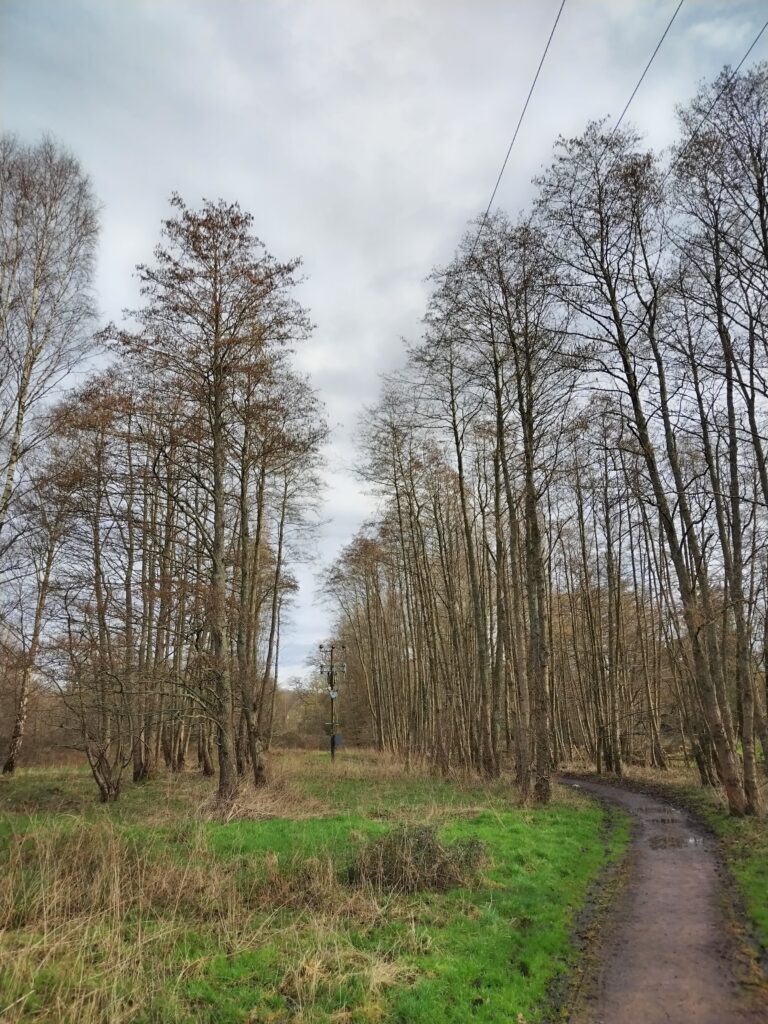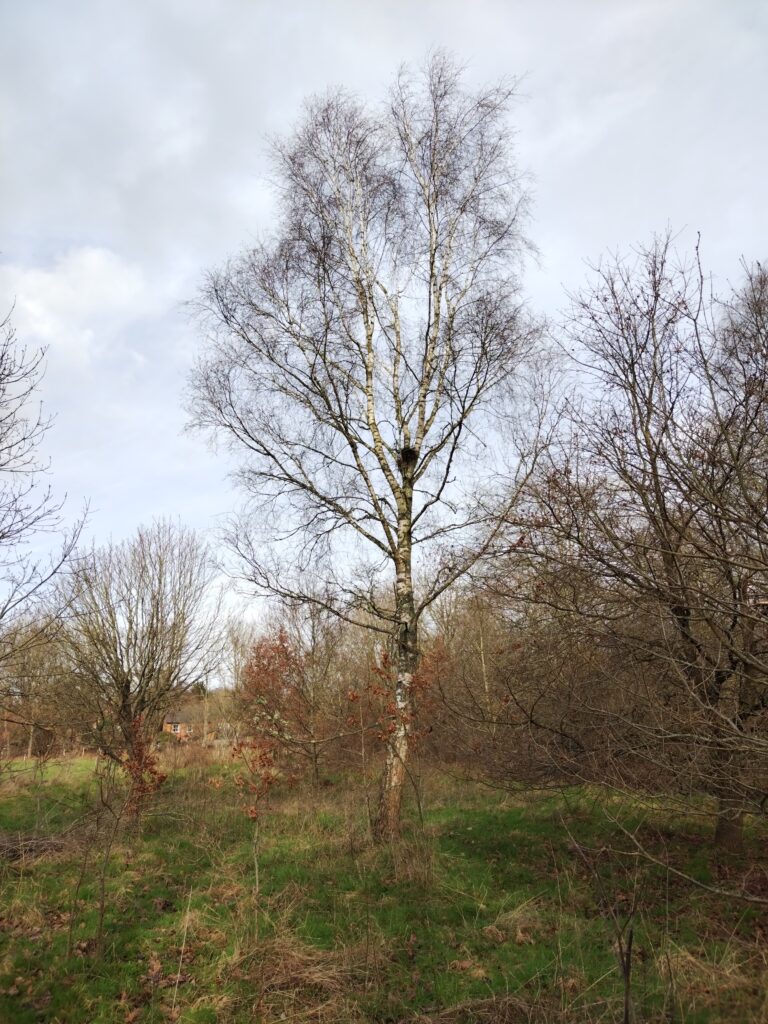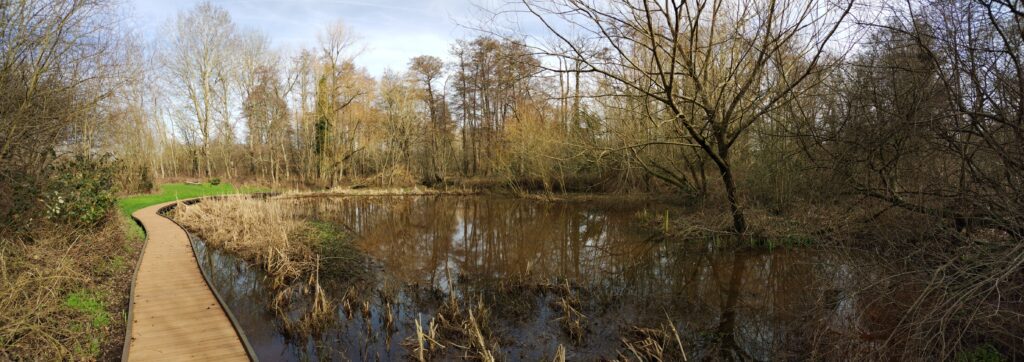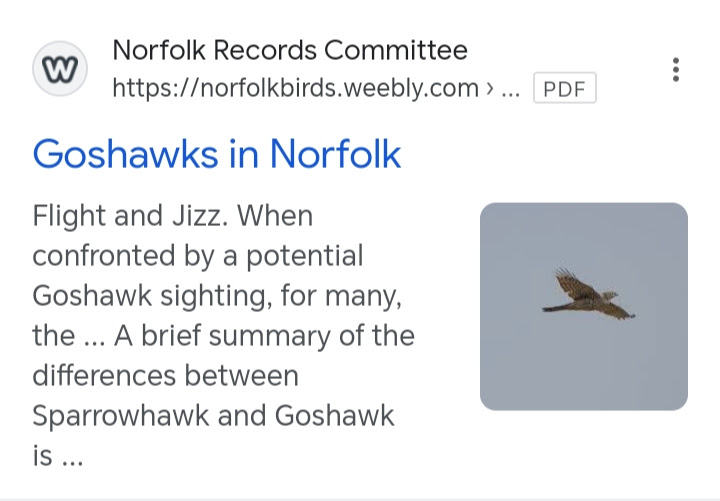Potentially contentious sighting as you will see when you read on. It is due to the nature of the bird in question that it is contentious.
con·ten·tious
ADJECTIVE
Data from Oxford languages
- causing or likely to cause an argument; controversial
Fox Corner Community Wildlife Reserve called me today. It’s the time of year for hearing or beginning to hear common frog (Rana temporaria). The weather was fair for February (15th 2024). At one point on my journey over to the reserve the van dashboard was saying that it was 15 degrees celsius. Certainly a spring like note in the air!
I took some pictures of a couple of trees that caught my eye and one of my favourite winter shots over the pond.



In previous blogs I write about my sit spot (this is one example of an article) which I returned to. I hadn’t done this kind of nature connection for some time. It was a joy albeit a little uncomfortable just sitting and listening to the bird song. It took a few moments to let the traffic from the road fade out in the background. One of the bird species I was alerted to had been there when I arrived but I couldn’t locate them. That was the siskin (Carduelis spinus). A small flock of about 15 flew by as I sat and listened. I saw a few of them later as I walked along the board walk. A grey wagtail (Motacilla cinerea) flitted in and out of the marshy area off to the right of the boardwalk as I headed in a southerly direction towards the river. I wouldn’t have noticed it if it had kept still which is something they seem to be incapable of doing! Whilst I had been sitting on my perch I saw my first brimstone (Gonepteryx rhamni) of the year. As I moved further into the reserve I saw a couple more. The first one I saw was a female; it looked more like a large white (Pieris brassicae) butterfly yet without the black edging.
I walked around the winding river drinking in the sights and sounds and ended up at an intersection in the reserve just after one of the small bridges. I was updating the list of birds I had seen on Bird Track, the thing I do for science which can be a little addictive. I was alerted by some small reedy warning calls coming from some tits, to a bird of prey. Low over the woods flying in a southwest direction was a long narrow tailed hawk. It was about buzzard size. Quite pronounced, reminiscent of a giant cuckoo but being February was the wrong time of year for that bird. It was bulky at the front. What was most distinctive was the movement. A long slow glide and then a flap. I watched it as long as I could through my binoculars as it disappeared over the trees towards Merrist Wood.
Up to this point I had been quite focussed. When I saw what I thought I saw I became very jittery. I may have seen a goshawk (Accipiter gentilis) before but not like this. (Yes I said goshawk!) I say may, as more often than not I’ve gone away thinking I’m not very sure I did see one. Yet this view was the closest view of one in the wild that I can recall. The screenshot below shows a picture of the shape that I saw including the narrow tail. For me I am pretty convinced that I saw this elusive bird of prey. Yet when it comes to sharing my news I am reluctant to do this with any records committee. This is where my sighting is contentious. Unfortunately I don’t carry a decent camera. By the time I would have got my phone ready it would have disappeared without me getting any descent shot.

Here is an article describing the differences between that
https://norfolkbirds.weebly.com/uploads/1/3/0/2/13028371/goshawk_id.pdf
of a goshawk and sparrowhawk (Accipiter nisus):
This dilemma of whether to share a finding is a tough one. I have had possible goshawk sightings before but not as convincing as this. I felt this one was different. I’ve never seen this kind of gliding before in sparrowhawks. It was uncanny and set me all of a jitter and I couldn’t focus on anything else. The image is forever impressed on my mind.
A birdwatching friend of mine has thought he’s seen a possible nest in the direction that it was flying this to me was another good reason for me to think it had to be a goshawk. This is still not enough evidence to state categorically that it was this bird though.
In searching for more evidence of what I’ve seen I checked out some footage of two goshawks flying together and the way they are flying was just like the individual that I saw. The video can be seen here.
Goshawks for those of you who don’t know are elusive birds and more often than not when people think they’ve seen one, so the story goes, it turns out it was actually a sparrowhawk (Accipiter nisus).
As I walked away I was reminded of a dream that I had a couple of years ago:
I’m in a car park with cars arriving with my birding gear. It’s very real and I feel like I’m actually there. I see my Countryside Ranger friend but he doesn’t see me at first. I set off and end up with a load of people tagging along. We saw some birds fly over the type of which I can’t recall. The landscape is like a country park. I approach where I thought the gate was to get into the park but the three gates are all blocked, grown over or barred. I say “We can go this way. It’s not the usual way but it’s the way all the same”. Somehow I’m very confident and the people I’m with trust me and go with it!
There’s a hedge to our left and some fence or other boundary to our right. It’s a narrow track but grass covered.
As we move on into the tree line to our left from our right come three birds of prey. One of which is more defined in colour on its breast which it tilts towards us showing very rich rusty orange spotting but becoming more blotchy. The other two are similar but less well defined and also smaller. I call out what they are and something about the different one. A voice behind me says ‘goshawk’ just like they knew that’s what it was. This sets me a quiver and a lot goes on inside my being. What I mean by that is there’s analysis, observation, processing, desire all rolled into one. In calling out the birds names something happens which I can’t recall fully. I actually thought I was awake seeing it. I desired to pursue the birds as they flew very low into the wood.
In both of these instances words can’t really describe very well what transpired. In the first account I am convinced I have seen something unusual. The small birds knew that it was a bird of prey. I knew from their calls that it was that too. From having seen buzzards (Buteo buteo), sparrowhawk and red kite (Milvus milvus) none of these matched what I saw. Incidentally I was still blown away by what I saw, I thought I could hear a horse neighing, flying over my head!! It turned out to be a couple of red kites which weren’t immediately apparent, above me. I wasn’t fully tuned into the moment!
I didn’t think until after being reminded of the dream that I may have had a theophany of the divine or a hierophany .
Religious Context: In a religious context, theophany is often used to describe a direct manifestation of God or a divine being. Hierophany, on the other hand, may be used to describe the manifestation of the sacred through symbols or objects. For example, in Christianity, the burning bush that Moses encountered would be considered a theophany, while the cross would be considered a hierophany.
Theophany vs Hierophany: When And How Can You Use Each One? (thecontentauthority.com)
Anthropological Context: In an anthropological context, the choice between theophany and hierophany may depend on the specific culture being studied. Some cultures may place more emphasis on direct encounters with the divine (theophany), while others may rely more on symbols or objects to represent the sacred (hierophany). For example, in Hinduism, the statues of deities in temples would be considered hierophanies, while the stories of Krishna’s divine interventions would be considered theophanies.
Artistic Context: In an artistic context, the choice between theophany and hierophany may depend on the specific medium being used. For example, in literature, theophany may be used to describe a character’s direct encounter with the divine, while hierophany may be used to describe the use of symbolism or metaphor to represent the sacred. In visual art, theophany may be used to depict a direct manifestation of the divine, while hierophany may be used to depict symbols or objects that represent the sacred.
I was more aware of a theophany when I experienced the dream which was very distinctive and marked. In dreams I have had different types of bird or animal appearing but they have shown something more than what a bird or animal in the ‘real’ world would. Saying too much about it I feel diminishes what it was. A recent example from the poet Martin Shaw demonstrates this listen here: (listen at about 8 minutes in) https://www.youtube.com/watch?v=JNZZ9kSqQMQ or if instead of watching it his story is also on here or here after Paul Kingsnorth (who incidentally has some good things to say about the environment).
Suffice to say both instances have had a profound effect on me which I believe are life enriching. Maybe you too have had similar experiences.
